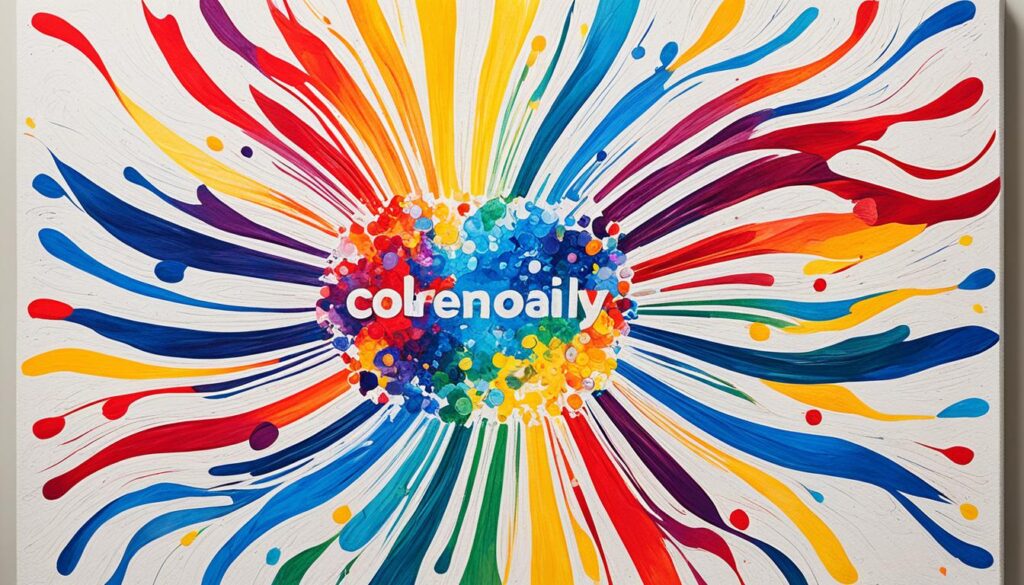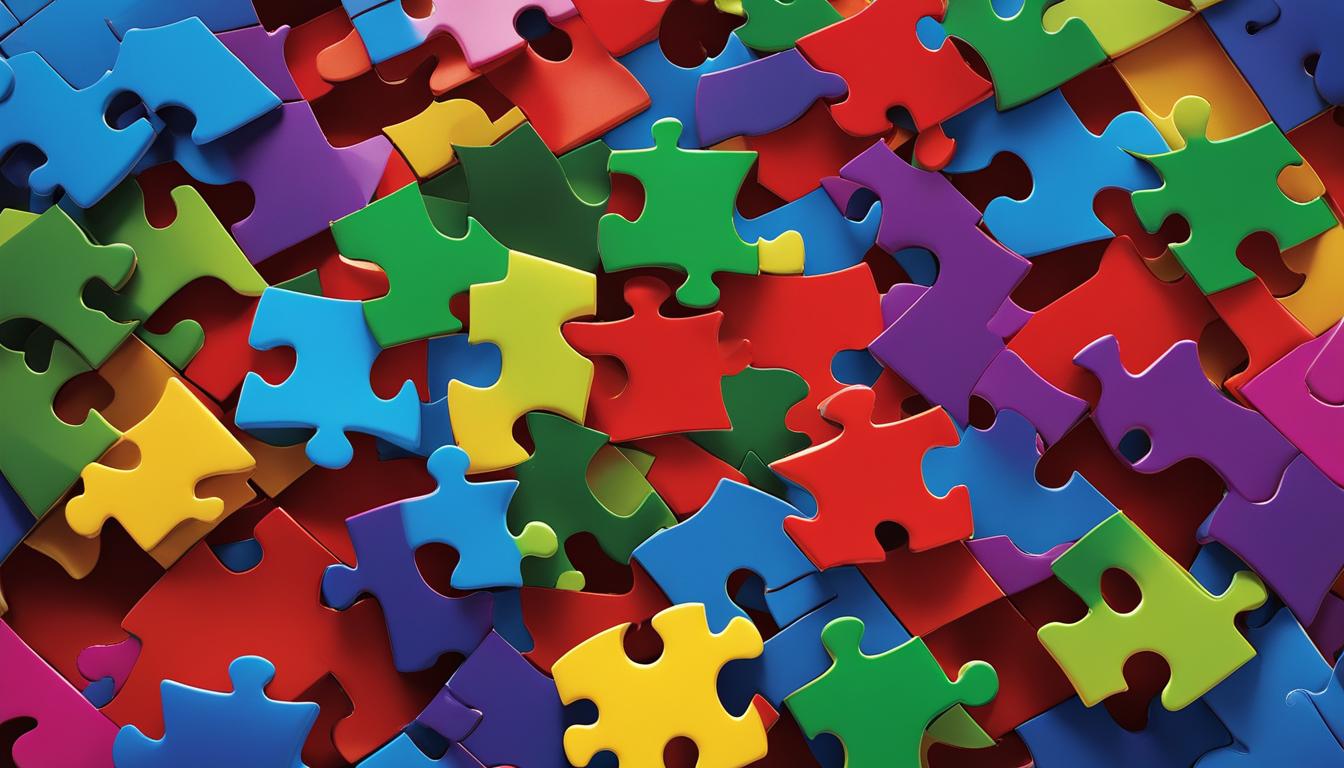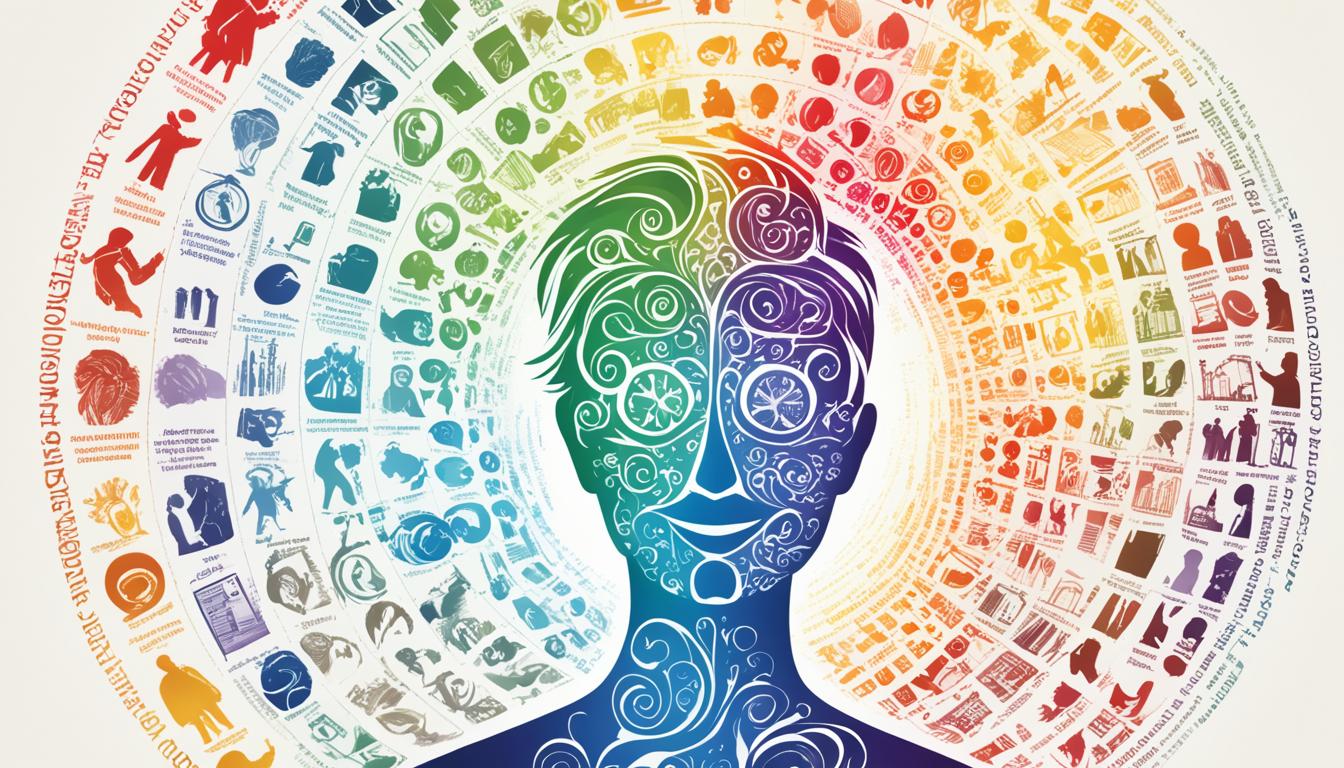Did you realize that your preferred color can provide intriguing insights into your personality? Whether you’re attracted to the intense passion of red, the soothing tranquility of blue, the peaceful harmony of white, or the vibrant energy of yellow, there’s a color personality test that can reveal the secrets of your inner motivations.
Understanding your color personality can be a powerful tool for self-discovery, personal growth, and building effective relationships. Each color represents a unique driving core motive and offers valuable insights into your behavior and motivations.
In this article, we will explore the meanings behind the red, blue, white, and yellow color personalities. By delving into the why behind our actions, we can gain a deeper understanding of ourselves and others, leading to greater self-development and more fulfilling connections.
Key Takeaways:
- Our favorite color can reveal insights into our personality and motivations.
- The color personality test identifies four driving core motives: power (red), intimacy (blue), peace (white), and fun (yellow).
- Understanding your color personality can lead to personal and professional growth.
- Each color has unique qualities and behaviors associated with it.
- Applying the insights from the color personality test can enhance relationships and self-awareness.
The Color Code Personality Profile
The Color Code Personality Profile is a powerful tool that unlocks the secrets of individuals’ innate personalities. It categorizes people into four distinct colors, each driven by a unique Driving Core Motive (DCM). By understanding the Color Code, we gain valuable insights into ourselves and others, enabling us to build more effective relationships, both personally and professionally.
The Color Code Personality Profile reveals our true colors and helps us understand the motives that drive our behavior. Let’s take a closer look at each color and their associated DCM:
| Color | Driving Core Motive |
|---|---|
| Red | Power |
| Blue | Intimacy |
| White | Peace |
| Yellow | Fun |
Each color represents a different aspect of our personality, shaping our thoughts, feelings, and actions. Understanding our own color and the colors of those around us allows us to navigate relationships with greater empathy and effectiveness.
For example, a Red individual is driven by power and achievement. They are natural leaders, assertive, and decisive. Blues, on the other hand, are motivated by intimacy and creating deep connections. They are loyal, empathetic, and focused on building meaningful relationships. Whites seek peace and harmony, valuing kindness, adaptability, and objectivity. Yellows are all about fun and living in the moment. They bring enthusiasm, spontaneity, and a sense of joy to any situation.
By understanding each color’s unique strengths and challenges, we can adapt our communication styles and connect more effectively with others. Whether at work, in our personal relationships, or during our leisure time, the Color Code Personality Profile illuminates the path to greater harmony and fulfillment.
Let’s explore how the Color Code can have a transformative impact on various aspects of our lives, from the workplace to our homes and leisure activities.

<!–
| Color | Driving Core Motive | Qualities |
|---|---|---|
| Red | Power | Responsible, Decisive, Proactive, Assertive |
| Blue | Intimacy | Loyal, Sincere, Thoughtful, Focused on Quality Connections |
| White | Peace | Kind, Adaptable, Patient, Objective |
| Yellow | Fun | Enthusiastic, Optimistic, Charismatic, Spontaneous |
–><!–
“The Color Code Personality Profile gives us valuable insights into our own and others’ personalities, helping us build stronger and more meaningful relationships.”
–>
Red: Motive { Power }
When it comes to personality, there is no color as powerful and influential as red. Red personalities are known for their unwavering drive to achieve results and their natural inclination towards leadership.
Reds possess a unique set of qualities that make them stand out in any setting. They have a clear vision of what they want to accomplish and are determined to make it a reality. This strong sense of purpose fuels their motivation, pushing them to take charge and make things happen.
The leadership abilities of red personalities are undeniable. They have a natural ability to inspire and guide others towards success. Their assertiveness and decisiveness allow them to make tough decisions and take swift action, even in the face of challenges or adversity.
Here are some key characteristics that define red personalities:
- Responsibility: Reds take responsibility for their actions and decisions. They understand the importance of accountability and strive to deliver on their promises.
- Decisiveness: Red personalities are known for their ability to make decisions quickly and confidently. They trust their instincts and are not afraid to take risks.
- Proactivity: Reds are proactive individuals who take initiative and seek opportunities for growth and advancement. They are not content with waiting for things to happen; they make things happen.
- Assertiveness: Red personalities have a strong presence and are not afraid to speak up and assert themselves. They are persuasive communicators who can effectively convey their ideas and influence others.

Reds thrive in roles that allow them to exercise their power and leadership qualities. They excel in positions of authority and are often found in leadership roles in various fields such as business, politics, and the military.
Despite their strong desire for results and high standards, red personalities also value efficiency, organization, and productivity. They are skilled at managing their time and resources effectively to maximize their output.
In summary, red personalities bring power, vision, and leadership to any situation. Their relentless drive for results and their ability to inspire and motivate others make them a force to be reckoned with.
Blue: Motive { Intimacy }
Blue personalities are driven by a deep yearning for intimacy and authentic connections with others. They value relationships and prioritize creating meaningful bonds that are built on trust and vulnerability. Blues are known for their loyalty, sincerity, and thoughtfulness, making them reliable and empathetic companions in both personal and professional settings.
Blue individuals approach relationships with a focus on quality rather than quantity. They crave emotional depth and are willing to invest time and effort in cultivating connections that are built on mutual understanding and shared experiences. Blues are highly attuned to the emotions and needs of others, often providing a nurturing and supportive presence.
Whether it’s with friends, family, or romantic partners, blues excel at creating a safe space for open and honest communication. They actively listen and engage in meaningful dialogue, allowing their loved ones to express themselves without judgment. The blue color personality’s ability to foster intimacy helps create strong and lasting relationships that are built on trust and mutual respect.
“A blue personality takes joy in deep, meaningful connections and cherishes the moments of vulnerability that strengthen their relationships.”
The Qualities of a Blue Color Personality
Blues possess a range of qualities that contribute to their ability to foster intimacy and create meaningful connections:
- Loyalty: Blues are incredibly loyal friends and partners, standing by their loved ones through thick and thin.
- Sincerity: Blue individuals are genuine and authentic in their interactions, valuing honesty and transparency.
- Thoughtfulness: They go the extra mile to show they care, often remembering important dates and offering support when it’s needed.
- Empathy: Blues have a natural ability to understand and empathize with the emotions of others, offering a comforting presence.

Enhancing Relationships with a Blue Personality
When interacting with a blue personality, it’s important to recognize their need for intimacy and emotional connection. Here are some tips for enhancing relationships with blues:
- Engage in deep conversations: Initiate meaningful discussions that delve into personal experiences, beliefs, and feelings.
- Show appreciation: Recognize and acknowledge the thoughtfulness and loyalty that blues bring to the relationship.
- Build trust: Demonstrate trustworthiness by keeping their confidences and being reliable.
- Be open and vulnerable: Blues value emotional honesty and authenticity, so share your thoughts and feelings openly.
By understanding and appreciating the driving motive of a blue personality, relationships can flourish and deepen, creating a strong foundation of intimacy and emotional connection.
White: Motive { Peace }
White personalities embody the essence of peace. Their driving core motive is the pursuit of harmony and the absence of conflict. They value clarity and tolerance in their interactions with others, striving to create a peaceful environment for everyone. With their kind and gentle nature, they bring a sense of calmness and tranquility to any situation.
White individuals possess qualities that contribute to fostering peace and understanding. Their adaptability allows them to navigate through various circumstances with ease, while their patience enables them to approach challenges and differences with composure. They value objectivity, seeking to understand different perspectives and making fair judgments based on rationality.
By embracing the values of peace and tolerance, white personalities contribute to the growth of cohesive communities and nurturing relationships. They serve as mediators, helping to resolve conflicts and find common ground among others. Their ability to promote understanding and empathy allows them to build bridges between people with differing opinions and backgrounds.
The Qualities of White Personalities:
- Kindness
- Adaptability
- Patience
- Objectivity
“Peace is not the absence of conflict, but the ability to cope with it.” – Unknown
Embracing the peaceful mindset of white personalities can lead to a more harmonious world where acceptance and understanding flourish. By nurturing peace within ourselves and extending it to others, we can create an environment where everyone feels valued and respected.
Now, let’s take a look at how the other color personalities contribute to the rich tapestry of the human experience.

Yellow: Motive { Fun }
Yellow personalities thrive on fun and the joy of living in the moment. They possess an innate ability to find delight in the simplest of things. Yellows have a contagious enthusiasm that can uplift the spirits of those around them. Their optimistic outlook on life enables them to approach new experiences with an open mind and a sense of adventure.
“The best way to have fun is to just let go and embrace the spontaneity of the moment.”
Yellows bring a sense of excitement and playfulness to any situation they encounter. They have a natural ability to connect with others, making them charismatic and sociable individuals. Their upbeat energy and ability to find humor in everyday life make them a joy to be around.
Living life to the fullest is a top priority for yellows. Whether it’s trying out new activities, exploring new places, or engaging in creative pursuits, they have an innate thirst for fun and adventure. Yellows understand the importance of enjoying the journey rather than solely focusing on the destination.
| Yellow Color Personality Traits | |
|---|---|
| Charismatic | Individuals with yellow personalities possess a natural charm and magnetism that draws others towards them. |
| Spontaneous | Yellows embrace the unexpected and love to go with the flow, often making impulsive decisions in the pursuit of fun. |
| Sociable | They thrive in social settings and enjoy building connections with people from all walks of life. |
| Optimistic | Yellows have a positive outlook on life, always seeing the silver lining and inspiring others to do the same. |
As vibrant as a sunflower, yellows bring a ray of sunshine wherever they go. Their ability to infuse fun and spontaneity into any situation makes them a valuable asset to any team or social circle.
“The beauty of embracing fun is that it not only brings joy to our lives but also allows us to create lasting memories.”
Next, we’ll explore the impact of the Color Code Personality Profile on individuals’ personal and professional relationships.

The Impact of the Color Code Personality Profile
The Color Code Personality Profile has a significant impact on individuals in various areas of life. It helps improve relationship dynamics, enhances self-awareness, increases team effectiveness, and promotes personal and professional growth. Understanding the motives of oneself and others leads to more effective communication and building stronger and more meaningful relationships.
Improving Relationship Dynamics
The Color Code Personality Profile provides valuable insights into the motivations and behaviors of individuals, enabling a deeper understanding of themselves and others. By recognizing and appreciating the different driving core motives represented by the four colors, individuals can navigate relationships with greater empathy and understanding.
- Red personalities, driven by power, can learn to communicate their need for control and results while understanding and appreciating the contributions of others.
- Blue personalities, motivated by intimacy, can foster deeper connections by openly expressing their emotions and actively listening to others.
- White personalities, driven by peace, can create harmonious relationships by valuing the opinions and perspectives of others and avoiding unnecessary conflict.
- Yellow personalities, motivated by fun, can bring joy and excitement to relationships by encouraging spontaneity and embracing a lighthearted approach to life.
Enhancing Self-Awareness
Understanding the motives behind our actions is the key to unlocking self-awareness and personal growth.
The Color Code Personality Profile shines a light on our driving core motives, helping us gain insight into why we behave the way we do. This increased self-awareness empowers us to recognize our strengths and weaknesses, manage our emotions more effectively, and make conscious choices that align with our authentic selves.
Increasing Team Effectiveness
The Color Code Personality Profile extends its impact beyond individual relationships to enhance teamwork. By understanding the diverse motivations and communication styles of team members, the profile helps foster collaboration, improve problem-solving, and create a more harmonious and productive work environment.
| Driving Core Motive | Strengths | Communication Style |
|---|---|---|
| Red (Power) | Leadership, decisiveness, assertiveness | Direct, goal-oriented, and results-driven |
| Blue (Intimacy) | Loyalty, empathy, thoughtfulness | Open, expressive, relationship-focused |
| White (Peace) | Kindness, adaptability, objectivity | Calm, diplomatic, consensus-driven |
| Yellow (Fun) | Enthusiasm, optimism, sociability | Charm, spontaneity, light-hearted |
Promoting Personal and Professional Growth
With a deeper understanding of ourselves and others, the Color Code Personality Profile becomes a catalyst for personal and professional growth. By aligning our choices, goals, and activities with our driving core motives, we can live a more fulfilling and purpose-driven life.
Whether it’s pursuing a career that aligns with our natural strengths and motivations, expanding our interpersonal skills to build stronger relationships, or simply making choices that bring us joy and fulfillment, the Color Code empowers us to take charge of our personal growth and create a life that resonates with who we truly are.

Applying the Color Code at Work
When it comes to our professional lives, understanding how we are perceived by others and leveraging our strengths is key to career advancement. That’s where the Color Code Personality Profile comes in. By identifying and embracing our driving core motives, we can excel in our chosen fields and foster effective relationships with our colleagues.
By applying the Color Code at work, we gain valuable insights into our own personalities and those of our teammates. This understanding allows us to tailor our communication and work styles to better collaborate and achieve shared goals. Whether you’re a Red, Blue, White, or Yellow personality, leveraging your driving core motive can turbocharge your effectiveness in the workplace.
“Applying the Color Code at work has revolutionized the way I approach my career. By understanding my own driving core motive and that of my co-workers, I can tailor my leadership style to maximize team effectiveness and build stronger professional relationships. It has been instrumental in my career advancement.”
– Jane Smith, Marketing Manager
Enhancing Career Advancement Opportunities
When we know our own Color personality and understand the driving core motives of others, it becomes easier to navigate the dynamics of the workplace. We can leverage our strengths and adapt our communication styles to connect with our colleagues on a deeper level. This enhanced understanding allows us to build effective relationships, gain influence, and seize career advancement opportunities.
For example, Reds, driven by power and achievement, can harness their leadership skills to take charge of projects and lead teams to success. Blues, motivated by intimacy, excel in nurturing relationships and fostering collaboration. Whites, seeking peace, bring a calm and objective perspective to complex situations. And Yellows, driven by fun and spontaneity, infuse their work environments with enthusiasm and creativity.
Boosting Team Effectiveness
A truly effective team is one where each member understands their individual driving core motive and that of their teammates. When team members have this knowledge, they can adapt their communication and work styles to create a collaborative and harmonious environment.
By applying the Color Code at work, teams can leverage the diversity of their members’ color personalities to achieve optimal results. Reds can provide strong leadership and assertiveness, Blues can foster open communication and trust, Whites can ensure clarity and objectivity, and Yellows can inject energy and motivation into the team. This synergy enhances team effectiveness and allows each member to contribute their unique strengths.

By embracing the Color Code Personality Profile in the workplace, we can unlock our full potential and pave the way for career advancement and increased team effectiveness. Understanding our own driving core motive and those of our colleagues allows us to communicate more effectively, build stronger professional relationships, and achieve success in our chosen fields.
Applying the Color Code at Home
At home, the Color Code can be a powerful tool for creating harmony, understanding, and effective parenting. By applying the Color Code principles within your family, you can enhance your self-perception, improve your parenting skills, and cultivate stronger family bonds.
Creating a Clear Self-Perception
Understanding your driving core motive through the Color Code allows you to have a clear and accurate perception of yourself. By recognizing your strengths and weaknesses, you can better navigate family dynamics and interactions. This self-awareness enables you to approach parenting and family relationships with greater intention and authenticity.
Understanding Each Child’s Motive
Every child has a unique driving core motive that influences their behavior. By understanding each child’s color, you can tailor your parenting approach to meet their individual needs. For example, a Red child may respond well to clear expectations and structure, while a Blue child may thrive on emotional connection and quality time. By recognizing and addressing each child’s specific motive, you can foster their personal growth and strengthen your parent-child relationship.
Speaking the Language of Each Family Member
Just as every child has a different driving core motive, each family member may have their own color personality. By speaking the language of each family member, you can effectively communicate and connect with them. Adapt your communication style to meet their needs and preferences. For instance, a White family member values peace and harmony, so finding common ground and approaching conflicts with a calm and objective mindset can strengthen your bond. By embracing and respecting the unique colors within your family, you can build a supportive and inclusive environment.
“Applying the Color Code at home allows us to understand each family member in a deeper and more meaningful way. It’s like speaking their language, fostering stronger connections and creating a loving and accepting home.”
Incorporating the Color Code into your home life can transform your parenting approach and strengthen family bonds. By cultivating self-awareness, understanding each child’s motive, and communicating effectively, you can create a nurturing and harmonious environment where everyone feels seen, heard, and valued.

Applying the Color Code at Play
Living a fulfilled life and enjoying the moment is essential for our overall well-being. By applying the Color Code in our leisure activities, we can align our experiences with our driving core motive, allowing us to fully embrace the present. Let’s explore how we can make the most of our leisure time based on our color profile.
Red: Power and Productivity
For individuals with a Red personality, engaging in activities that provide a sense of power and productivity is key. This may include participating in competitive sports, organizing events, or taking up leadership roles in recreational clubs. By pursuing activities that allow them to showcase their strength and drive, Red personalities can find fulfillment and satisfaction.
Blue: Meaningful Connections
Individuals with a Blue personality thrive on deep and meaningful connections. They enjoy engaging in activities that promote bonding and intimacy. Joining discussion groups, book clubs, or engaging in creative pursuits such as painting or writing can provide the sense of connection that Blues value. By immersing themselves in activities that foster emotional connections, Blue personalities can truly enjoy their leisure time.
White: Harmony and Relaxation
White individuals seek peace and harmony in their leisure pursuits. Engaging in activities that promote relaxation and tranquility is essential for them. Options such as practicing yoga, meditation, or spending time in nature can help Whites unwind and recharge. By prioritizing activities that bring them a sense of peace, White personalities can fully enjoy their leisure time.
Yellow: Spontaneity and Fun
Yellows are all about living in the moment and experiencing spontaneous fun. Engaging in adventurous activities, exploring new hobbies, or attending social events can bring joy and excitement to Yellows. By embracing the spontaneous nature of life and seeking opportunities for fun, Yellow personalities can make the most of their leisure time.
| Color | Relevant Activities |
|---|---|
| Red | Competitive sports, leadership roles, organizing events |
| Blue | Discussion groups, book clubs, creative pursuits |
| White | Yoga, meditation, spending time in nature |
| Yellow | Adventurous activities, exploring new hobbies, social events |
By understanding our Color Code and prioritizing activities that resonate with our driving core motives, we can create a fulfilling and enjoyable leisure time that aligns with who we are. So go ahead, embrace your color, and make the most of every moment!

The Unique Features of the Color Code Personality Profile
The Color Code Personality Profile sets itself apart from other personality profiles by focusing on the identification of driving core motives. Unlike traditional profiles that primarily analyze behavior, the Color Code delves deeper and explores the underlying reasons behind our actions, offering profound insights into our true nature.
What makes the Color Code truly unique is its user-friendly approach and ease of implementation. By utilizing colors to represent each driving core motive, it provides a practical and accessible means of understanding ourselves and those around us.
“The Color Code Personality Profile goes beyond surface-level analysis and takes us on an introspective journey to uncover the driving forces behind our behavior.”– Dr. Jane Spencer, Ph.D.
The Color Code empowers individuals to gain a clearer understanding of themselves and their motivations. By identifying their color, they can leverage this knowledge to enhance their personal and professional relationships, communicate effectively, and achieve personal growth.

Key Features of the Color Code Personality Profile
- Identification of driving core motives
- Deeper insights into personality
- User-friendly and easy to implement
- Utilizes colors for clear representation
- Practical and accessible tool for self-discovery
In summary, the Color Code Personality Profile stands out for its ability to reveal the driving forces behind our actions, offering unique and valuable insights into our personalities. With its user-friendly approach and emphasis on driving core motives, the Color Code is a powerful tool for personal growth, improving relationships, and understanding ourselves and others on a deeper level.
Conclusion
The Color Code Personality Profile offers a powerful and insightful approach to understanding ourselves and others. By uncovering our driving core motive and recognizing the motives of those around us, we gain a deeper understanding of our behaviors and motivations. This knowledge equips us to navigate personal and professional relationships with greater empathy and success.
Unlike other personality profiles, the Color Code goes beyond surface-level descriptions and dives into the why behind our actions. It helps us understand the underlying driving forces that shape our behaviors, enabling us to make conscious choices and steer our lives in alignment with our true selves.
With the Color Code, we gain a practical tool for self-discovery and personal growth. Whether we’re looking to enhance our relationships, advance our careers, or simply live a more fulfilling life, the Color Code provides valuable insights and guidance. By embracing our unique driving core motive and embracing the diversity of others’ motives, we can foster deeper connections, improve communication, and create a harmonious environment for growth and development.
FAQ
What is the Color Code Personality Profile?
The Color Code Personality Profile is a tool that reveals individuals’ innate personalities and represents them as one of the four colors. Each color is driven by a unique Driving Core Motive (DCM). Reds are driven by power, blues by intimacy, whites by peace, and yellows by fun.
How does the Color Code Personality Profile impact individuals?
The Color Code Personality Profile has a significant impact on individuals in various areas of life. It helps improve relationship dynamics, enhances self-awareness, increases team effectiveness, and promotes personal and professional growth.
How can I apply the Color Code at work?
Applying the Color Code at work helps individuals understand how they are perceived by others and play to their strengths for career advancement opportunities. It also enhances team effectiveness, as team members can better understand and communicate with one another based on their driving core motives.
How can I apply the Color Code at home?
Applying the Color Code at home enables individuals to create a clear and accurate self-perception and enhances their ability to relate effectively to family members. It improves parenting skills by understanding each child’s driving core motive and promotes stronger family bonds by speaking the language of each family member.
How can I apply the Color Code at play?
The Color Code helps individuals determine their personal needs and wants to live a fulfilled life. By understanding their own color and the influence of their secondary color, individuals can align their activities and experiences with their driving core motive, enabling them to fully enjoy the present moment.
What makes the Color Code Personality Profile unique?
The Color Code Personality Profile stands out from other personality profiles due to its focus on identifying driving core motives. It goes beyond behavior and explores the why behind actions, providing deeper insights into one’s personality. The Color Code is user-friendly and easy to implement, utilizing colors to represent driving core motives, making it practical and accessible.
Emmeline is the backbone of our content creation team, bringing complex psychological concepts to life with clarity and empathy. As our Expert Writer, she crafts engaging, insightful articles that guide readers through the intricacies of personality assessments and what they reveal about the human condition. Her passion for psychology and personal development shines through in every piece she writes.










